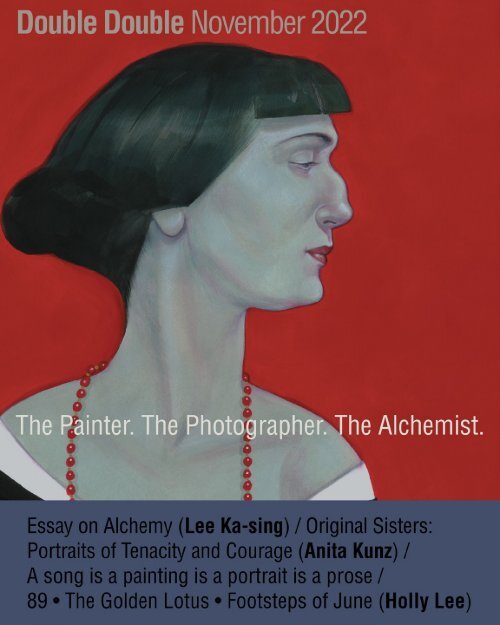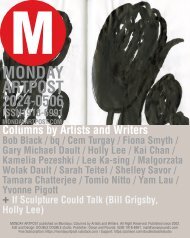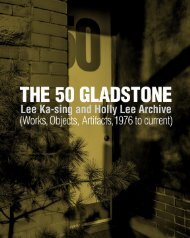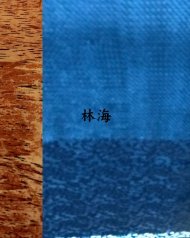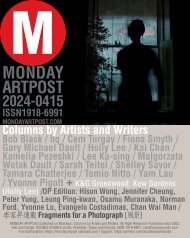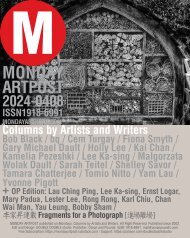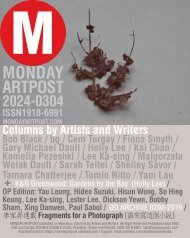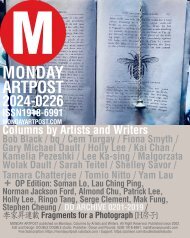You also want an ePaper? Increase the reach of your titles
YUMPU automatically turns print PDFs into web optimized ePapers that Google loves.
Double Double 2022-11
DOUBLE DOUBLE 2022-11<br />
<strong>The</strong> <strong>Painter</strong>. <strong>The</strong> <strong>Photographer</strong>. <strong>The</strong> <strong>Alchemist</strong>.<br />
A Holly Lee and Lee Ka-sing Publication<br />
First published in Canada by OCEAN POUNDS<br />
November 2022<br />
ISBN: 978-1-989845-53-0<br />
Library and Archives Canada Cataloguing in Publication<br />
Photography, Visual Art, Poetry, Literature, Culture<br />
Authors: Anita Kunz, Holly Lee, Lee Ka-sing<br />
Copyright © Ocean Pounds 2022<br />
Individual Copyrights belong to the Artists and Writers.<br />
All Rights Reserved.<br />
For information about permission to reproduce material<br />
from this book, please write to mail@oceanpounds.com<br />
DOUBLE DOUBLE was published as a weekly webzine<br />
from January 2019 to December 2021. 158 issues were<br />
published. Full archives are available online:<br />
https://oceanpounds.com/blogs/doubledouble<br />
Some issues were re-packaged and published as<br />
print-on-demand paperback editions.<br />
Since January 2022, DOUBLE DOUBLE has become a<br />
monthly publication, released in both paperback (POD)<br />
and ebook versions. POD is available for orders at OCEAN<br />
POUNDS in Toronto or online at BLURB (blurb.com).<br />
<strong>The</strong> <strong>Painter</strong>. <strong>The</strong> <strong>Photographer</strong>. <strong>The</strong> <strong>Alchemist</strong>.<br />
DOUBLE DOUBLE ebook edition is available for read-on-line at<br />
Reading Room https://oceanpounds.com/blogs/rr<br />
Subscribe and Support<br />
https://patreon.com/doubledoublestudio<br />
Design and Editorial by DOUBLE DOUBLE studio<br />
www.doubledouble.org<br />
Front cover image: Anita Kunz<br />
End pages: Lee Ka-sing<br />
Some artwork featured in this publication might be available<br />
at OCEAN POUNDS. Inquiry by email: mail@oceanpounds.com<br />
OCEAN POUNDS<br />
50 Gladstone Avenue, Toronto,<br />
Ontario, Canada M6J 3K6<br />
www.oceanpounds.com
Lee Ka-sing<br />
Essay on Alchemy<br />
Book 2 (2017)<br />
28 photographs
Anita Kunz<br />
Original Sisters:<br />
Portraits of Tenacity<br />
and Courage<br />
A selection of 50 paintings from a series of portraits<br />
dedicated to women of accomplishments. <strong>The</strong> book<br />
was published by Random House Canada in 2021,<br />
with a foreword by Roxane Gay.
Ada Blackjack<br />
Hero of the Arctic<br />
Ada Lovelace<br />
<strong>The</strong> world’s first computer programmer
Adelaide Herrmann<br />
Vaudeville performer dubbed the Queen of Magic<br />
Alice Guy Blache<br />
French cinema pioneer
Angela Davis<br />
Political activist, philosopher and author<br />
Angela Ruiz Robles<br />
Inventor of the mechanical<br />
encyclopedia (precursor to the e-book)
Anna Akhmatova<br />
Poet<br />
Anna Mae Aquash<br />
Mi’kmaq activist
Anonymous<br />
<strong>The</strong> first artists of the human species were likely female<br />
Augusta Savage<br />
Educator, social activist and portrait sculptor
Camille Claudel<br />
Sculptor<br />
Candace Pert<br />
Neuroscientist and pharmacologist
Caroline Earle White<br />
Animal protectionist<br />
Cecilia Payne-Gaposchkin<br />
Astronomer, astrophysicist
Christine Jorgensen<br />
Transgender woman known in the U.S<br />
for her gender reassignment surgery<br />
Saint Elizabeth of Hungary<br />
Princess who gave up her wealth to care for the poor, patron saint of the Secular Franciscan Order
Hatshepsut<br />
Longest-reigning female pharaoh<br />
Hedy Lamarr<br />
Movie star who also invented the frequency hopping technology
Hilma Af Klint<br />
Artist, mystic whose abstract paintings were influenced by spiritualism<br />
Hypatia<br />
Mathematician, astronomer and philosopher
Ida B. Wells<br />
Writer, activist for African Americans equal justice<br />
Irena Sendler<br />
Humanitarian rescuing Jews from WWII
Irna Phillips<br />
Actress and writer for radio and TV who developed the modern soap opera<br />
Jeanne De Clisson<br />
Former noblewoman turned privateer
Jeanne Labrosse<br />
Balloonist, parachutist, and aviation pioneer<br />
Jeffrey Catherine Jones<br />
Transgender woman illustrator and comic<br />
artist in the fantasy art genre
Josephine Baker<br />
Iconic dancer and singer garnering most popularity in Paris<br />
Juliane Koepcke<br />
German Peruvian mammalogist
Lady Mary wortley Montagu<br />
Aristocrat moved to Istanbul and witnessed<br />
the first form of a smallpox vaccine<br />
Lise Meitner<br />
Physicist who contributed to the discovery<br />
of nuclear fission
Elizabeth Magie<br />
Writer and feminist, created the<br />
precursor to the board game<br />
Monopoly<br />
Lorraine Hansberry<br />
Writer, civil right activist
Louise Lecavalier<br />
Dancer and choreographer, an icon in the<br />
world of contemporary dance<br />
Margaret Keane<br />
<strong>Painter</strong> recognized for her oversized,<br />
doe-like eyes of her subjects
Maria Montessori<br />
Physician, innovator in childhood education<br />
Maria Sibylla Merian<br />
Scientific illustrator and naturalist famous for her<br />
studies of insects
Marie Skłodowska–Curie<br />
Physicist and chemist pioneering research on radioactivity<br />
Maud Wagner<br />
Circus performer and the first female tattoo artist in the United States
Nina Simone<br />
Pianist, singer, songwriter and civil rights activist<br />
Noor Inayat Khan<br />
British spy in WWII, first female wireless<br />
operator to assist the French Resistance
Queen Charlotte<br />
England's first Black queen<br />
Rachel Carson<br />
Marine biologist and author, one of the key<br />
figures in the modern environmental movement
Remedios Varo<br />
Surrealist artist<br />
Ruby Bridges<br />
First African American child in an<br />
all-white public elementary school
Saint AEbbe <strong>The</strong> Younger<br />
Martyr, cut her nose to avoid rape by Viking marauders<br />
Stormé Delarverie<br />
Gay rights activist
Temple Grandin<br />
Animal behavior expert who is on the autism spectrum<br />
Vivian Maier<br />
Street photographer who was discovered<br />
and celebrated only after her death
Yma Sumac<br />
Peruvian American soprano<br />
Zofia Posmysz<br />
Journalist and author known<br />
for her novel <strong>The</strong> passenger
Anita Kunz is a Canadian-born artist and<br />
illustrator living in Toronto. Her work has<br />
been published and exhibited internationally<br />
for four decades. Her work has been featured<br />
regularly in and on covers of many magazines,<br />
including Time, Rolling Stones, and the New<br />
York Times Magazines. She has illustrated<br />
covers for the New Yorker and more than<br />
fifty book jackets. Kunz has been inducted<br />
into the Society of Illustrators stamp. She has<br />
been appointed Officer of the Order of Canada<br />
(QC), and has received the Queen Elizabeth II<br />
Diamond Jubilee Medal.<br />
<strong>The</strong> portraits in the collection of “Original<br />
Sisters: Portraits of Tenacity and Courage”<br />
bring the accomplishments of trailblazers,<br />
leaders, mentors, and rebels together in<br />
a series of paintings that embody Anita’s<br />
approachable and engaging style. <strong>The</strong> entire<br />
Original Sisters collection, with 365 portraits,<br />
is on public display at TAP Centre for<br />
Creativity, London, Ontario, from November<br />
3rd, 2022 to January 4th, 2023.
A song is a painting is<br />
a portrait is a prose<br />
written by Holly Lee<br />
From Barber to Agee to Evans<br />
<strong>The</strong> first time I heard James Agee’s words were set to music, and sung by a soprano<br />
with a beautiful voice. I didn’t know him then, and gradually get to know him a little<br />
more. Not enough. Because of the music, the words and the poetry, I was driven to buy<br />
his book A Death in the Family.<br />
Agee’s rapturous prose-poem, Knoxville: Summer, 1915 was written in less than an<br />
hour and a half, and on his revision, stayed 98 percent faithful to the original writing.<br />
When I heard the music for the first time, I immediately fell for it. I was eager to<br />
know, who’s the composer, who’s the lyricist, who performed it. It was Samuel Barber,<br />
who set Agee’s Knoxville to music, and the version that I’d heard was sung by Renée<br />
Fleming. Obviously, my knowledge in contemporary classical music is as limited as my<br />
proficiency in 20th Century literature. But that doesn’t matter, I’ve become infatuated<br />
by both composer and writer since.
Described as “lyric rhapsody” by Barber, he used about 1/3 of the prose-poem for<br />
the score, conjuring up a 16-minute dramatic song for soprano and orchestra. <strong>The</strong>re<br />
is a universality of idyllic, nostalgic beauty in the work, that even for a person from<br />
the Far East could grasp and resonate. <strong>The</strong> shortened prose set in lines was already<br />
very impressive, but reading the original prose; I was enraptured with the free flow of<br />
language, the meticulous observation of everyday life in amplified details, sentences<br />
filled with humanity and purity of the heart.<br />
On the bookshelf there is an old book I bought in the late eighties, which I rarely<br />
touch, and remember only its approximate contents. It was about the Farm Security<br />
Administration project; about some photographs taken by Walker Evans and text<br />
written by James Agee—a documentation of the lives of three impoverished tenant<br />
farmers during America’s Great Depression. I bring this up because, after some twenty<br />
years, I finally picked up Walker Evans’s 650 pages biography and start reading. It<br />
was from this point I remember the book “Let Us Now Praise Famous Men”, the book<br />
I mentioned above. <strong>The</strong> book, with its photographs and text, left the world an indelible<br />
impression on the poverty-stricken American South in the 30s. In it, I found a written<br />
account of Agee by Evans. I was struck by its vividness and unconventional style of<br />
writing, full of wit, beaming with life and personality. It is a “written” portrait of James<br />
Agee. Walker Evans is not only a great photographer, he is unequivocally a brilliant<br />
writer.<br />
I could have ignored, and kept ignoring Agee’s prose and poetry, and Evans’s<br />
photography, had I not been touched incidentally by Barber’s Knoxville. Music leads<br />
to words, and words lead to imagery, which brings me back to writing. As I learn more<br />
about Barber’s music, I’m impacted by his Adagio for Strings, which I have heard<br />
before, but not knowing: it is one of the saddest compositions in contemporary classical<br />
music.<br />
<strong>The</strong> Original Sisters to <strong>The</strong> Golden Lotus<br />
Anita Kunz acknowledged women of significance, known or unknown, with her brush<br />
strokes. Recently she has created a substantial body of work, bringing illustrious<br />
females front and centre to the printed page, naming the book “Original Sisters”.<br />
Drawing one portrait a day, the two year lockdown period gave her plenty of quiet<br />
time to focus on this project. Most characters in the series are long gone, and some<br />
she was only made aware of from her friends. <strong>The</strong> way she portrayed the figures relied<br />
mainly on public sources, and images she found on the Internet—very generic, and<br />
generalized. With her experience and well-versed skill, she deftly picked up heat and<br />
intensity of the individuals, modified and idealized with her personal touch.<br />
In the portrait of Anna Akhmatova, she set her against a red background, her sharp<br />
profile characterized by the nasal bump, and a fringe. Her hair is tied back into a<br />
soft bun, a red bead necklace hung down her shoulders stressing their roundness by<br />
the low-cut V-shaped dress. One can almost hear Akhmatova’s line: you will hear<br />
thunder and remember me, and think: she wanted storms. Camille Claudel is another<br />
beguiling portrait. <strong>The</strong> overall tone of the painting clings to an earthly brown. Her head<br />
and shoulders are elongated; her hair unkempt, raining down in rings of frenzy; her<br />
face is like porcelain, cracked and broken like her mental state, her intelligence and<br />
virtuosity are reflected by the delicately painted French embroidered lace. After almost<br />
close to a century, Camille Claudel’s sculptures are widely accepted, and proclaimed<br />
as great as Rodin’s—her once teacher, mentor, and lover.<br />
As Kunz celebrates the achievement of distinguished women in pictures, I contemplate<br />
on the submissive roles Chinese women have endured over the centuries, ever more<br />
feeling the privilege of living in a better, freer world of gender and racial equality. In<br />
1989, I was invited to work on a multi-platform art project, which had incorporated<br />
dance, performance, drama, music and photography. It was based loosely on the<br />
Chinese classical novel: <strong>The</strong> Golden Lotus. <strong>The</strong> novel took place in the 12th century,<br />
and encompassed many female characters, which made me think about the three-inch<br />
golden lotus—the synonym for the bound feet of women. I proposed to take a suite<br />
of portraits of the artists. Not deliberately, but out of subconsciousness, many of the<br />
portraits I took possessed strong gestural bearings of the hands and feet.<br />
When I was asked to participate in <strong>The</strong> Golden Lotus Project, the Tiananmen Square<br />
protests had just started in China. My approach to the portrait series of the performers<br />
and musicians was not meant to be direct interpretation of the characters in the book,<br />
and the six weeks of protests in China ending in bloodshed perturbed me immensely.<br />
It reflected clearly in my portrait of the musician Peter Suart. Suart, a young English<br />
lad born in Hong Kong, was in Beijing during the incident. He was a first-hand witness
ut left the capital before the brutal crack down. We worked together on the idea of<br />
the shot. In the shooting session, he wore the leather trench coat he bought in Beijing,<br />
grabbing two spiky Indonesian musical instruments acting as sharp claws; he spread<br />
his wings and soared like an eagle. <strong>The</strong> background was an old poem, composed and<br />
made into woodcut by Ka-sing. <strong>The</strong> poem was about free will, and choice. Tea or<br />
coffee. My title of the work echoed these thoughts. It came to be: 89 • <strong>The</strong> Golden<br />
Lotus • Footsteps of June (1989) 八 九 • 金 瓶 梅 • 六 月 前 後 .<br />
taking off my wartime garments. I’m putting on my old time wear. Gently, gently, I’m<br />
releasing and combing my long-tangled hair. Before the mirror I stare, ornamenting my<br />
brow with gold floral print cut in pairs. Stepping outside, I’m calling to my comrades.<br />
Shocked and startled, not even my confidant recognizes me! Oh, my companions<br />
for twelve long years. Listen to me, and look. Some distance away, among the thick<br />
bushes, a male rabbit scurried north; a female rabbit looked vague and lost. Both<br />
running, dear mates, are you able to tell if this one a buck, or that one a doe?”<br />
Buck or Doe: <strong>The</strong> Ballad of Mulan 木 蘭 辭 , a re-imagination<br />
She became a warrior by necessity, at a time when well water could not be mixed with<br />
river water. She was that quiet water knitting from dawn to dusk; her sole music came<br />
from her own breathing; her loom click click and click click.<br />
A troubled, unrest heart. How was her old father to fight? <strong>The</strong> Khan was merciless;<br />
soldiers were just numbers, recruited fast and perished fast. She would take up the<br />
duty, cut her hair, bind her breasts, wear her boots, and head to the market. East to get<br />
a fine stead; west, a saddle; south, a bridle, and north a long whip. Farewell farewell<br />
my parents. By dusk I’d be resting by the Yellow River, another dusk on the black<br />
mountains of Mongolia. Your calling became so feeble, I couldn’t bear to hear.<br />
Ten thousand miles she rode and battled, swept through fields and mountain passes.<br />
<strong>The</strong> north wind blew, the gong hit at midnight. Her armour shimmered under cold,<br />
silvery light. For ten years she fought on countless battlefields, battered bodies laid<br />
bare, and unsettled. For ten years, she combated and survived, returned gloriously,<br />
kneeling to meet her emperor. On his high throne he offered her praise, high rank, and<br />
gold. All these to her, were moon in the water, flower in the mirror. All she asked for<br />
was a good horse, accompanying her in her toilsome journey, speeding her safely back<br />
to her village; back to home, sweet home.<br />
Postscript<br />
In our age, most people associate Mulan as a Disney cartoon character of Asian origin,<br />
a woman disguised as a man going to battle for his aging father. Mulan is a fictional<br />
folk heroine from China’s Northern dynasties (Northern Wei, 386-534 AD), a time<br />
when many famous Buddhist rock-cut cave temples were constructed at Yungang<br />
and Longmen. Mulan is believed to be of Chinese/Xianbei ancestry (no bound feet!).<br />
Mulan is perhaps even a tribal name, leaving the highly regarded heroine, like<br />
many others, anonymous. But her brave deeds have survived and inspired people for<br />
many centuries. <strong>The</strong> Ballad of Mulan is collected from oral traditions, transcribed<br />
into written language, as a beautiful rhymed song. Though there are many English<br />
translations of this ballad available on the Internet, I have the urge to re-imagining the<br />
scene, and re-writing it in a prose form.<br />
Her news of returning reached home faster than her feet. Her father, mother walked<br />
out of the city arm-in arm. Her neighbours all came out to greet. Her sister rouged her<br />
cheeks in rosy red; her brother whetted his knife for pigs and sheep.<br />
Entering from east chamber door, settling on west chamber bed, she sings, “I’m
Holly Lee<br />
89 • <strong>The</strong> Golden Lotus<br />
• Footsteps of June<br />
八 九 • 金 瓶 梅 •<br />
六 月 前 後<br />
15 photographs
Mui Cheuk Yin 梅 卓 燕<br />
performer
Peter Suart 彼 得 小 話<br />
musician
Lindsay Chan 陳 令 智<br />
performer
Kung Chi Shing 龔 志 成 , Peter Suart 彼 得 小 話<br />
musicians
Kung Chi Shing 龔 志 成<br />
musician
Pia Ho 何 秀 萍<br />
performer
Sunny Pang 彭 錦 耀<br />
choreographer
Miguel Zermeno<br />
performer
Norman Fung 馮 唸 慈<br />
performer
Robert Fung 馮 萬 剛<br />
performer
Norman Fung 馮 唸 慈 , Sunny Pang 彭 錦 耀<br />
choreographers
Pia Ho 何 秀 萍 , Margaret Lee 李 翠 玲<br />
performers
Margaret Lee 李 翠 玲<br />
performer
Frances Tao 陶 馥 蘭<br />
performer
89 • <strong>The</strong> Golden Lotus • Footsteps of June<br />
八 九 • 金 瓶 梅 • 六 月 前 後
89 • <strong>The</strong> Golden Lotus • Footsteps of June<br />
八 九 • 金 瓶 梅 • 六 月 前 後<br />
Fifteen photographs in a series<br />
12 x 16 inch, FUJICHROME Super gloss reversal print<br />
(1989)<br />
This photo project was within a larger, multi-layered<br />
project sparking off a dance performance accompanied<br />
with live music, and an art installation—inspired and<br />
created around the Chinese classic novel <strong>The</strong> Golden<br />
Lotus. Composed in the early 17th Century the novel<br />
is considered one of the six major classics of Chinese<br />
literature.<br />
When I was asked to join the Golden Lotus Project, the<br />
Tiananmen Square protests had just started in China.<br />
<strong>The</strong> series I proposed to take portraits of the performers<br />
and musicians was never direct interpretation of the<br />
characters in the book. But the six weeks of protests<br />
ended in bloodshed did affect the way I felt and the<br />
feelings injected into these photographs, and the title of<br />
the exhibition echoed these thoughts.<br />
89 • <strong>The</strong> Golden Lotus • Footsteps of June is not a big<br />
series; it consists only of fourteen prints. But looking<br />
back, it was a pleasant collaboration with the artists<br />
involved in this project. <strong>The</strong> photographs were shown<br />
at 97 Brasserie and Le Cardre Gallery (1989) in Hong<br />
Kong. A few years later, three images from the series was<br />
exhibited at Contemporary Photography from Mainland<br />
China, Hong Kong and Taiwan (1994, Hong Kong Arts<br />
Centre) as C-type prints in a bigger size (image 18”x36”,<br />
frame size 50”35”).<br />
Published here, are images directly scanned from the<br />
suite which was originally exhibited at Le Cardre Gallery.<br />
Print size is 12”x16”, reversal photographs printed from<br />
colour transparencies.


